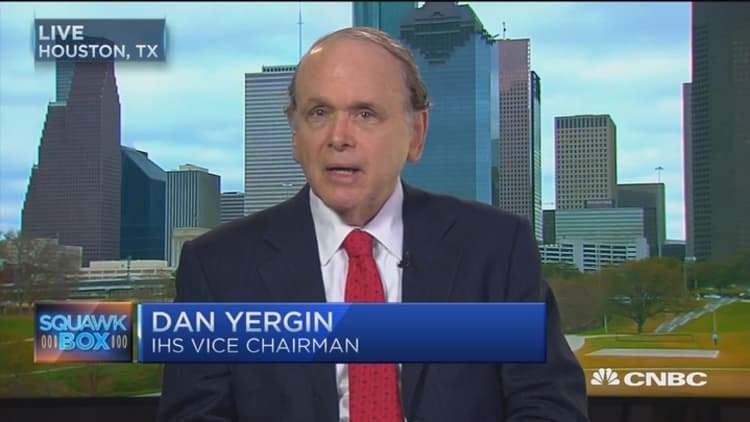
Since crude prices cratered, no oil-producing country has eliminated as much production as the U.S.
After OPEC's November 2014 decision to let the market set prices, the price of oil declined, yet U.S. oil production continued to gain temporarily, topping out at 9.6 million barrels a day in April. But since then, U.S. output has fallen by about a half million barrels a day, dipping to 9.1 million barrels a day in the latest weekly government figures. More declines are expected.
"Nowhere else in the world have we seen that type of swing down," said Jim Burkhard, IHS chief researcher of global oil markets.
And this trend is projected to continue, according to the International Energy Agency and other energy industry market watchers.
U.S. shale players and the global energy industry descend on Houston this week for the 35th annual IHS CERAWeek energy conference and will hear directly from top OPEC officials on the policy that has helped drive oil prices down 70 percent from their highs.
OPEC Secretary General Abdallah Salem El-Badri speaks Monday afternoon. Ali al-Naimi, the oil minister from Saudi Arabia, which led the 2014 switch to market-based pricing, will speak at the conference Tuesday morning.
His remarks will be key, since just last week Saudi Arabia and Russia agreed to a production freeze if other producers join in. Production would be set at January levels, when Russia was pumping more than 10.8 million barrels a day, a post–Soviet Union high, and Saudi Arabia was at about 10.2 million barrels a day.
"Even if (Naimi) is repeating everything he said before, it will be an important message either way," said Burkhard.
As oil prices fell into the $30s, the pain intensified for producers. Producing nations are shaving budgets and cutting domestic programs, but they continue to pump high levels of crude.
But the U.S. industry responds differently, and the dozens of companies that make it up traditionally respond quicker to price moves than other producers.
"That's why we call [the U.S.] the swing producer," said Burkhard. Yet the U.S. shale industry has proved to be more resilient than expected, and it has been able to continue production at lower pricing levels

Citigroup forecasts that U.S. production could keep falling until next year if prices stay low.
"Our most recent forecast had U.S. production fall to as low as 8 million or 8.1 million barrels a day, until 2017. The lower the price level, the lower the drilling, and the more likely production declines in the U.S. will be higher," said Edward Morse, Citigroup's global head of commodities research in a recent interview.
The talk of a possible freeze by the world's largest oil producers has helped push oil prices higher, but it is also being met with skepticism, since it does not include any cutbacks in output. The other issue is that Iran has said it supports the deal but has not said it would agree to go along. Iran is in fact adding oil to the market, as it is in the process of recapturing export business now that sanctions against its nuclear program have been lifted.
Russia's Energy Minister, Alexander Novak, said Saturday that consultations on a preliminary deal to freeze production should be completed by March 1. He said other non-OPEC producers, like Mexico and Norway, will be consulted. Oil ministers from both those countries will be speaking at CERAWeek.
But the producer that will not be consulted is the U.S., which became a more powerful force in the world oil market with the boom of the tight oil industry. Unlike countries with state-owned oil companies, however, there is no one switch that will turn off or on U.S.production except for price.
Our most recent forecast had U.S. production fall to as low as 8 million or 8.1 million barrels a day, until 2017.Edward Morseglobal head of commodities research, Citigroup
"What's different this time has been the big variable: the U.S. The U.S. showed an incredible capacity to grow production at an incredible rate. That's the disruptor. That's the change. The only thing that talks to U.S. producers is the price of oil," said Burkhard.
The U.S. industry has slashed budgets, chopped capital spending and laid off workers. According to IHS, the top U.S. companies are cutting back capital spending by more than 50 percent in 2016 over 2015 levels.
"Their guidance just three months ago was not that severe,"said Burkhard.
But the U.S. industry could also come back faster than the producers in other parts of the world. Most of the 5-million-barrels-a-day jump in oil production between 2010 and 2015 was due to the unconventional drilling in the U.S.
"We think if oil prices get to $50, U.S. production would start to grow again," said Burkhard. He said it would take the industry six to nine months to resume.
According to the IEA in its midterm outlook released Monday, total U.S. liquids production is expected to increase from 2015 levels by a net 1.3 million barrels per day by the end of 2021.





